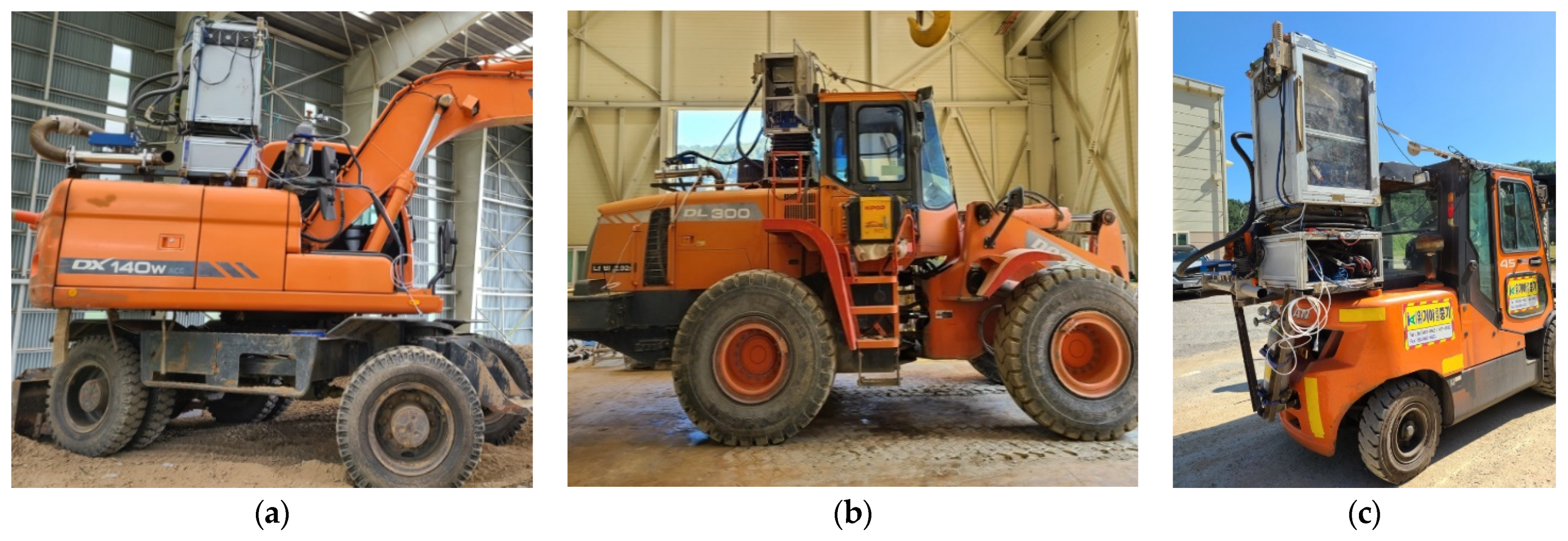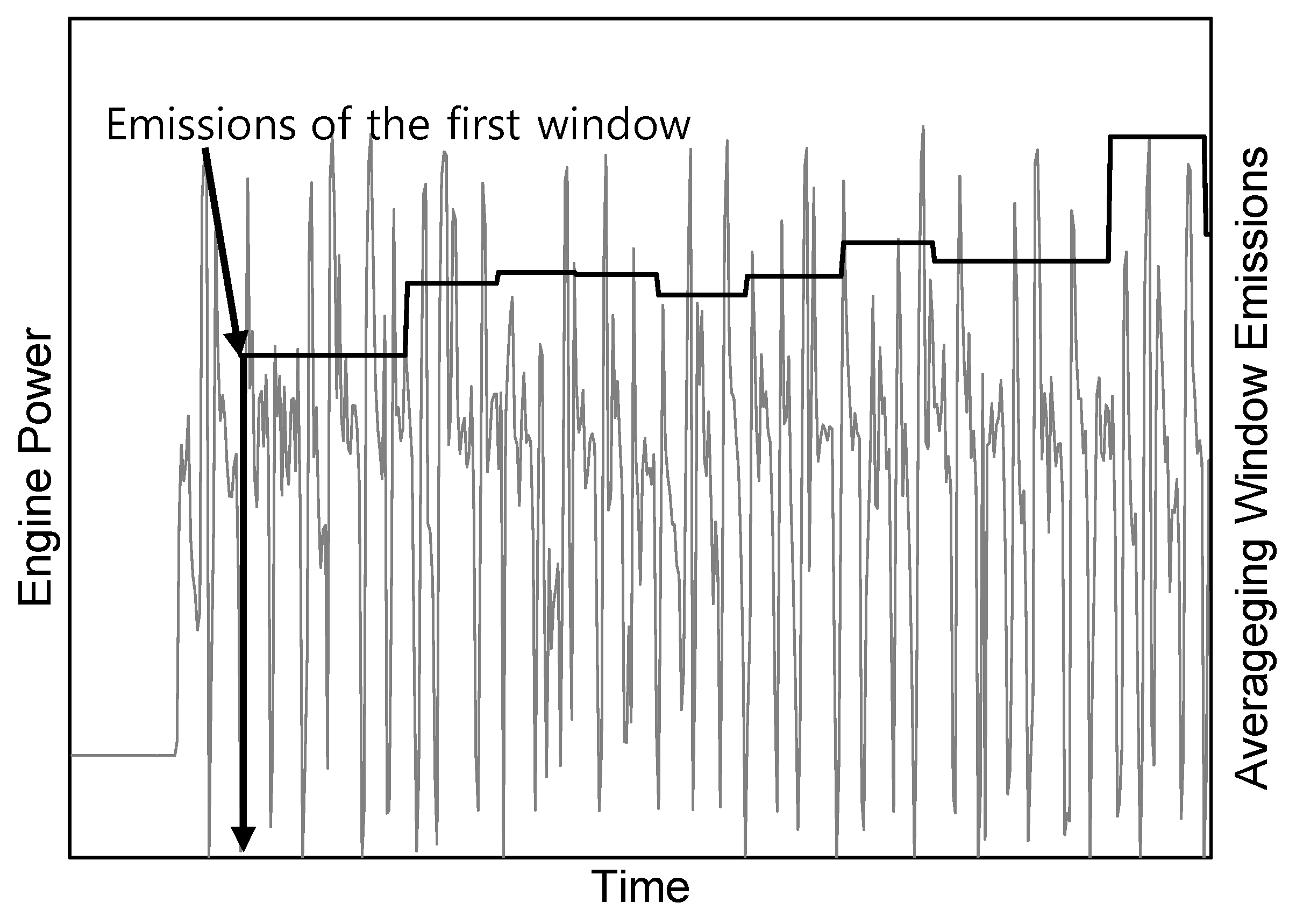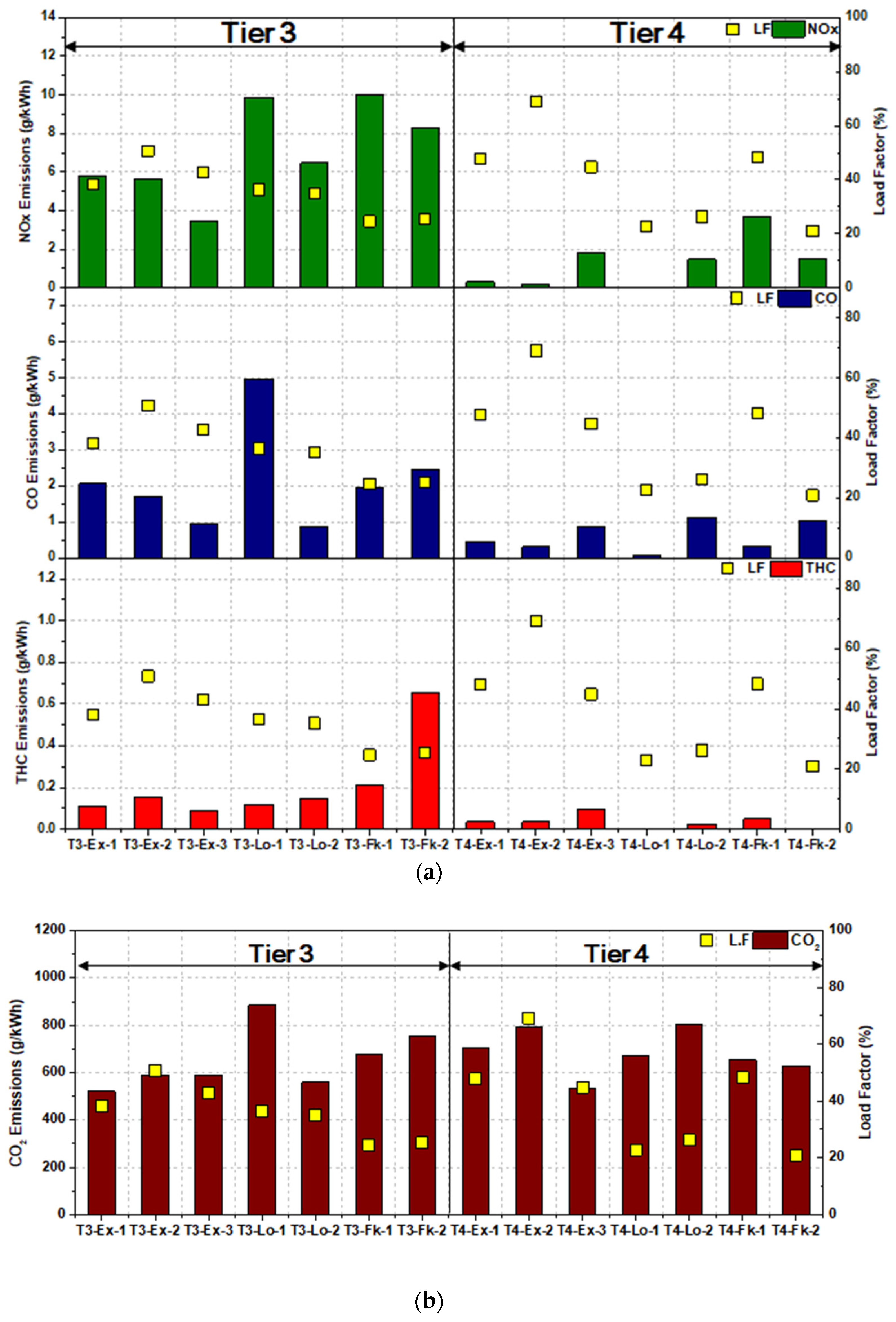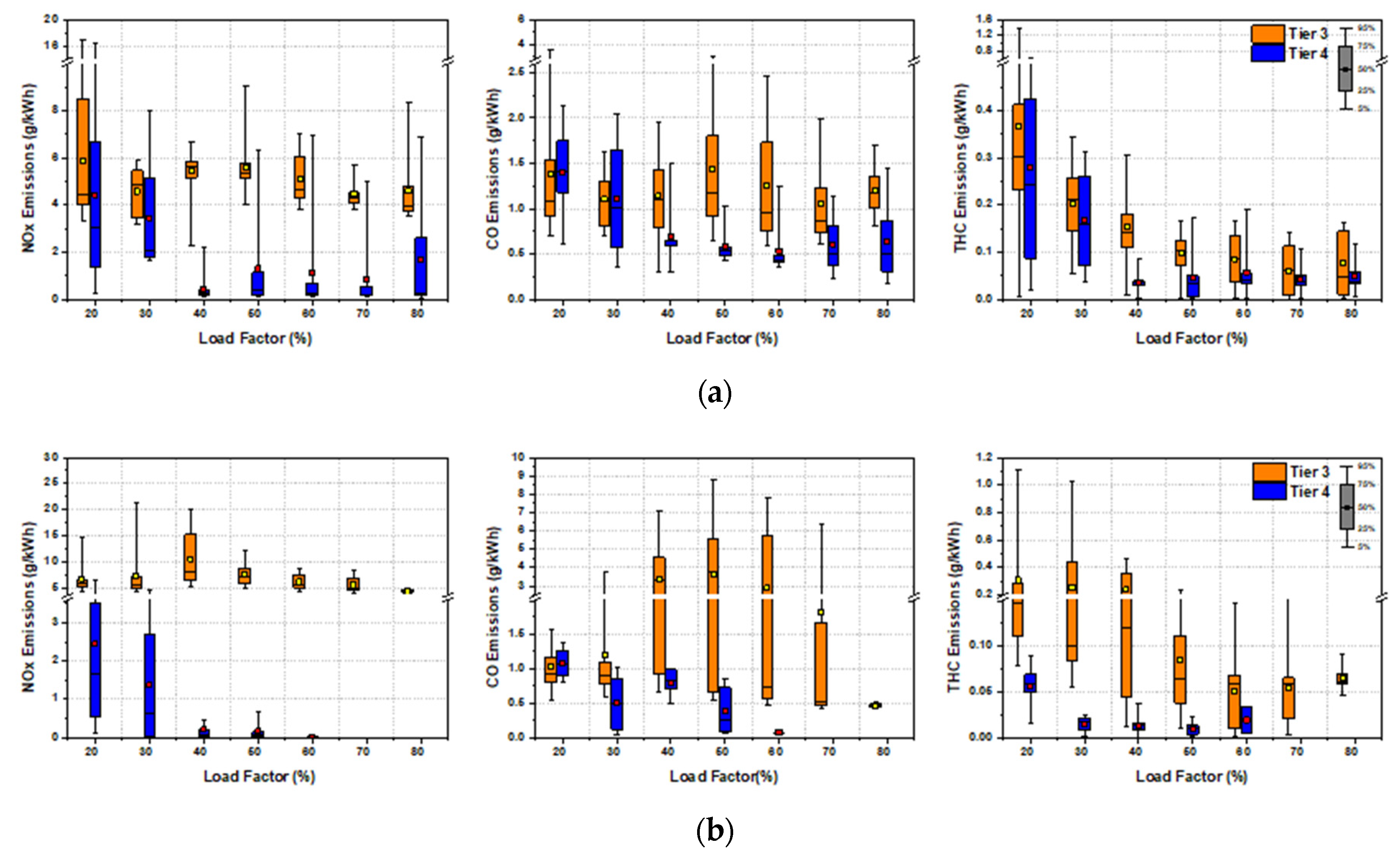Characteristics of Real-World Gaseous Emissions from Construction Machinery
Abstract
1. Introduction
2. Materials and Methods
2.1. Construction Machinery Tested
2.2. PEMS System
2.3. Real-World Works Performed with the Tested Construction Machinery
2.4. Data Analysis
3. Results and Discussion
3.1. Engine Driving Characteristics for Construction Machinery
3.2. Average Brake-Specific Emissions
3.3. Average Emissions in Real-World Working Modes for Construction Machinery
3.4. Emission Factor Development Based on Moving Averaging Window Analysis
4. Conclusions
Author Contributions
Funding
Data Availability Statement
Conflicts of Interest
Ethics Statement
References
- National Air Emission Inventory and Research Center. Air Pollutants Emission Inventory. 2019. Available online: https://www.air.go.kr/jbmd/sub43.do?tabPage=0 (accessed on 28 April 2022). (In Korean).
- Korean Ministry of Environment. Korea Clean Air Conservation Act Chapter IV, Regulation of Exhaust Gases from Motor Vehicles and Ships, etc. 2021. Available online: https://www.air.go.kr/article/view.do?boardId=8&articleId=98&boardId=8&menuId=49¤tPageNo=1 (accessed on 25 March 2022). (In Korean).
- Korean Ministry of Land, Infrastructure, and Transportation. Statistics on Construction Machinery. 2021. Available online: http://stat.molit.go.kr/portal/cate/statView.do?hRsId=476&hFormId=&hSelectId=&sStyleNum=&sStart=&sEnd=&hPoint=&hAppr= (accessed on 31 December 2021). (In Korean).
- Desouza, C.D.; Marsh, D.J.; Beevers, S.D.; Molden, N.; Green, D.C. Real-world emissions from non-road mobile machinery in London. Atmos. Environ. 2020, 223, 117301. [Google Scholar] [CrossRef]
- EPA-420-B-16-022; Non-Road Compression-Ignition Engines: Exhaust Emission Standards. United States Environmental Protection Agency: Washington, DC, USA, 2016.
- European Union. REGULATION (EU) 2016/1628 OF THE EUROPEAN PARLIAMENT AND OF THE COUNCIL of 14 September 2016 on requirements relating to gaseous and particulate pollutant emission limits and type-approval for internal combustion engines for non-road mobile machinery, amending regulations (EU) No 1024/2012 and (EU) No 167/2013, and amending and repealing Directive 97/68/EC, 2016. Off. J. Eur. Union 2016, 50, 1–76. [Google Scholar]
- ECE/TRANS/505/Rev.1/Add.95/Rev.3; Uniform provisions concerning the approval of compression ignition (C.I.) engines to be installed in agricultural and forestry tractors and in non-road mobile machinery with regard to the emissions of pollutants bythe engine, UN Regulation No. 96. Economic Commission for Europe of the United Nations UN/ECE: Geneva, Switzerland, 2014.
- Weiss, M.; Bonnel, P.; Kuhlwein, J.; Provenza, A.; Lambrecht, U.; Alessandrini, S.; Carriero, M.; Colombo, R.; Forni, F.; Lanappe, G.; et al. Will Euro 6 reduce the NOx emissions of new diesel cars?—Insights from on-road tests with Portable Emissions Measurement Systems (PEMS). Atmos. Environ. 2012, 62, 657–665. [Google Scholar] [CrossRef]
- Kwon, S.; Park, Y.; Park, J.; Kim, J.; Choi, K.-H.; Cha, J.-S. Characteristics of on-road NOx emissions from Euro 6 light-duty diesel vehicles using a portable emissions measurement system. Sci. Total Environ. 2017, 576, 70–77. [Google Scholar] [CrossRef]
- United States Environmental Protection Agency (EPA). California Notify Volkswagen of Clean Air Act Violations; 2015 Press Release; United States Environmental Protection Agency (EPA): Washington, DC, USA, 2015. [Google Scholar]
- Ricardo, S.-B.; Victor, V.; Michael, C.; Jelica, P.; Barouch, G.; Vicente, F.; Zlatko, K.; Covadonga, A. On-road emissions of passenger cars beyond the boundary conditions of the real-driving emissions test. Environ. Res. 2019, 176, 108572. [Google Scholar] [CrossRef]
- Park, J.; Shin, M.; Lee, J.; Lee, J. Estimating the effectiveness of vehicle emission regulations for reducing NOx from light-duty vehicles in Korea using on-road measurements. Sci. Total Environ. 2021, 767, 144250. [Google Scholar] [CrossRef]
- Grigoratos, T.; Fontaras, G.; Giechaskiel, B.; Zacharof, N. Real world emissions performance of heavy-duty Euro VI diesel vehicles. Atmos. Environ. 2019, 201, 348–359. [Google Scholar] [CrossRef]
- Ko, S.; Park, J.; Kim, H.; Kang, G.; Lee, J.; Kim, J.; Lee, J. NOx Emissions from Euro 5 and Euro 6 Heavy-Duty Diesel Vehicles under Real Driving Conditions. Energies 2020, 13, 218. [Google Scholar] [CrossRef]
- Abolhasani, S.; Frey, H.C.; Kim, K.; Rasdorf, W.; Lewis, P.; Pang, S.H. Real-World in-use activity, fuel use, and emissions for nonroad construction vehicles: A case study for excavators. J. Air Waste Manag. Assoc. 2008, 58, 15. [Google Scholar] [CrossRef]
- Johnson, K.; Barth, M.; Durbin, T.; Miller, W.; Russell, R.; Cocker, D.; Scora, G. Measuring and Modeling PM Emissions from Heavy-Duty Construction Equipment; Report CA11-1204, CE-CERT; University of California: Berkeley, CA, USA, 2012. [Google Scholar]
- Durbin, T.D.; Johnson, K.; Jung, H.; Russell, R. Study of In-Use Emissions from Diesel Off-Road Equipment; Report. CE-CERT; University of California: Berkeley, CA, USA, 2013. [Google Scholar]
- Bonnel, P.; Perujo, A.; Provenza, A.; Villafuerte, P.M. Non-Road Engine Conformity Testing Based on PEMS. JRC Sci. Policy Rep. 2012. [Google Scholar]
- Johnson, K.; Cao, T.; Durbin, T.; Russell, R.; Cocker, D.; Scora, G.; Maldonado, H. Evaluations of in-use emission factors from off-road construction equipment. Atmos. Environ. 2016, 147, 234–245. [Google Scholar]
- Environmental Protection Agency. Greenhouse Gas Emissions Standards and Fuel Efficiency Standards for Medium- and Heavy-Duty Engines and Vehicles. Final Rule, Federal Register, Code of Federal Regulations; Environmental Protection Agency: Washington, DC, USA, 2011; Volume 76. [Google Scholar]
- Tu, R.; Tiezhu, L.; Meng, C.; Chen, J.; Sheng, Z.; Xie, Y.; Xie, F.; Yang, F.; Chen, H.; Li, Y.; et al. Real-world emissions of construction mobile machines and comparison to a non-road emission model. Sci. Total Environ. 2021, 771, 145365. [Google Scholar] [CrossRef] [PubMed]
- Tan, D.; Tan, J.; Peng, D.; Fu, M.; Zhang, H.; Yin, H.; Ding, Y. Study on real-world power-based emission factors from typical construction machinery. Sci. Total Environ. 2021, 799, 149436. [Google Scholar] [CrossRef] [PubMed]
- European Union. COMMISSION DELEGATED REGULATION (EU) 2017/655 of 19 December 2016 supplementing Regulation (EU) 2016/1628 of the European Parliament and of the Council with regard to monitoring of gaseous pollutant emissions from in-service internal combustion engines installed in non-road mobile machinery. Off. J. Eur. Union 2017. [Google Scholar]
- Hajji, A.M.; Lewis, M.P. How to Estimate Green House Gas (GHG) Emissions from an Excavator by Using CAT's Performance Chart. In AIP Conference Proceedings; AIP Publishing LLC: Melville, NY, USA, 2017. [Google Scholar] [CrossRef]
- Savickas, D.; Steponavičius, D.; Špokas, L.; Saldukaitė, L.; Semenišin, M. Impact of Combine Harvester Technological Operations on GlobalWarming Potential. Appl. Sci. 2021, 11, 8662. [Google Scholar] [CrossRef]
- Savickas, D.; Steponavičius, D.; Domeika, R. Analysis of Telematics Data of Combine Harvesters and Evaluation of Potential to Reduce Environmental Pollution. Atmosphere 2021, 12, 674. [Google Scholar] [CrossRef]
- ECE/TRANS/505/Rev.1/Add.48/Rev.6; Uniform provisions concerning the measures to be taken against the emission of gaseous and particulate pollutants from compression ignition engines and positive ignition engines for use in vehicles; UN Regulation No. 49. United Nations: New York, NY, USA, 2013.
- European Union. Commission regulation (EU) 2018/1832 of 5 November 2018 amending Directive 2007/46/EC of the European Parliament and of the Council, Commission Regulation (EC) No 692/2008 and Commission Regulation (EU) 2017/1151 for the purpose of improving the emission type approval tests and procedures for light passenger and commercial vehicles, including those for in-service conformity and real-driving emissions and introducing devices for monitoring the consumption of fuel and electric energy. Off. J. Eur. Union 2017, L 301. [Google Scholar]
- Cha, J.; Lee, J.; Chon, M. Evaluation of real driving emissions for Euro6 light-duty diesel vehicles equipped with LNT and SCR on domestic sales in Korea. Atmos. Environ. 2019, 196, 133–142. [Google Scholar] [CrossRef]
- Bedotti, A.; Pastori, M.; Casoli, P. Modelling and energy comparison of system layouts for a hydraulic excavator. Energy Procedia 2018, 148, 26–33. [Google Scholar] [CrossRef]
- Filla, R. Representative Testing of Emissions and Fuel Consumption of Working Machines in Reality and Simulation. In Proceedings of the SAE 2012 Commercial Vehicle Engineering Congress, Rosemont, IL, USA, 24 September 2012. [Google Scholar]
- Zajac, P.; Rozic, T. Energy consumption of forklift versus standards, effects of their use and expectations. Energy 2022, 239, 122187. [Google Scholar] [CrossRef]
- Lee, T.; Park, J.; Kwon, S.; Lee, J.; Kim, J. Variability in operation-based NOx emission factors with different test routes, and its effects on the real-driving emissions of light diesel vehicles. Sci. Total Environ. 2013, 461–462, 377–385. [Google Scholar] [CrossRef] [PubMed]
- Young, L.; Costain group Climate Change Director. Reducing the Construction Machinery Carbon Footprint Through Data Driven Behaviours. Available online: https://www.costain.com/news/insights/reducing-the-construction-machinery-carbon-footprint-through-data-driven-behaviours (accessed on 22 April 2022).
- Yang, L.; Franco, V.; Campestrini, A.; German, J.; Mock, P. NOX control technologies for Euro 6 Diesel passenger cars. Int. Counc. Clean Transp. 2015. Available online: https://theicct.org/publication/nox-control-technologies-for-euro-6-diesel-passenger-cars/ (accessed on 22 April 2022).
- O'Driscoll, R.; Stettler, M.E.J.; Molden, N.; Oxley, T.; ApSimon, H.M. Real world CO2 and NOx emissions from 149 Euro 5 and 6 diesel, gasoline, and hybrid passenger cars. Sci. Total Environ. 2018, 621, 282–290. [Google Scholar] [CrossRef] [PubMed]
- Ro, S.; Park, J.; Shin, M.; Lee, J. Developing on-Road NOx Emission Factors for Euro 6b Light-Duty Diesel Trucks in Korean Driving Conditions. Energies 2021, 14, 1041. [Google Scholar] [CrossRef]
- Ntziachristos, L.; Samaras, Z. Sectoral Guidance 1.A.3.b Road Transport. EMEP/EEA Air Pollutant Emission Inventory Guidebook; European Environmental Agency: Copenhagen, Demark, 2019; Available online: https://www.eea.europa.eu/publications/emep-eea-guidebook-2019/part-b-sectoral-guidance-chapters/1-energy/1-a-combustion/road-transport-appendix-4-emission/view (accessed on 17 January 2020).










| Machine ID | Types | Model Year | Engine Net Power and Revolution (kW/rpm) | Engine Volume (L) | Korean Emission Regulation | Emission Control Technologies |
|---|---|---|---|---|---|---|
| T3-Ex-1 | Excavator | 2013 | 121/2100 | 5.9 | K-tier3 | Non |
| T3-Ex-2 | Excavator | 2013 | 121/2100 | 5.9 | K-tier3 | Non |
| T3-Ex-3 | Excavator | 2013 | 210/1800 | 7.8 | K-tier3 | EGR |
| T3-Lo-1 | Loader | 2010 | 191/1750 | 7.6 | K-tier3 | Non |
| T3-Lo-2 | Loader | 2013 | 405/2100 | 12.7 | K-tier3 | SCR |
| T3-FK-1 | Fork-lift | 2014 | 74/2300 | 3.4 | K-tier3 | EGR |
| T3-FK-2 | Fork-lift | 2014 | 81/2300 | 3.4 | K-tier3 | EGR |
| T4-Ex-1 | Excavator | 2017 | 141/1900 | 5.9 | K-tier4 | EGR, SCR, DOC |
| T4-Ex-2 | Excavator | 2017 | 110/2000 | 4.0 | K-tier4 | EGR, SCR, DPF, DOC |
| T4-Ex-3 | Excavator | 2015 | 336/1900 | 12.8 | K-tier4 | EGR, SCR, DPF, DOC |
| T4-Lo-1 | Loader | 2017 | 213/1800 | 7.6 | K-tier4 | EGR, SCR, DOC |
| T4-Lo-2 | Loader | 2016 | 129/2200 | 4.4 | K-tier4 | EGR, SCR, DOC |
| T4-FK-1 | Fork-lift | 2016 | 55/2200 | 3.8 | K-tier4 | EGR, DOC |
| T4-FK-2 | Fork-lift | 2017 | 73.5/2300 | 3.4 | K-tier4 | EGR, SCR, DOC |
| Machine I.D | Gaseous Emission Standard (g/kWh) | Emission Factors (g/kWh) | |||||
|---|---|---|---|---|---|---|---|
| CO | NMHC | NOx | NMHC + NOx | CO | THC | NOx | |
| T3-Ex-1 | 5.0 | - | - | 4.0 | 1.5 | 0.13 | 3.54 |
| T3-Ex-2 | 5.0 | - | - | 4.0 | 1.5 | 0.13 | 3.54 |
| T3-Ex-3 | 3.5 | - | - | 4.0 | 1.78 | 0.18 | 3.55 |
| T3-Lo-1 | 3.5 | - | - | 4.0 | 2.14 | 0.16 | 3.43 |
| T3-Lo-2 | 3.5 | - | - | 4.0 | 2.14 | 0.16 | 3.43 |
| T3-FK-1 | 5.0 | - | - | 4.7 | 1.79 | 0.17 | 3.69 |
| T3-FK-2 | 5.0 | - | - | 4.0 | 1.36 | 0.2 | 3.66 |
| T4-Ex-1 | 5.0 | 0.19 | 0.4 | - | 0.071 | 0.017 | 0.188 |
| T4-Ex-2 | 5.0 | 0.19 | 0.4 | - | 0.071 | 0.017 | 0.188 |
| T4-Ex-3 | 3.5 | 0.19 | 0.4 | - | 0.106 | 0.023 | 0.191 |
| T4-Lo-1 | 3.5 | 0.19 | 0.4 | - | 0.106 | 0.023 | 0.191 |
| T4-Lo-2 | 5.0 | 0.19 | 0.4 | - | 0.071 | 0.017 | 0.188 |
| T4-FK-1 | 5.0 | - | - | 4.7 | 0.391 | 0.078 | 3.501 |
| T4-FK-2 | 5.0 | 0.19 | 0.4 | - | 0.071 | 0.017 | 0.188 |
| Description | Method | Range | Accuracy | Resolution |
|---|---|---|---|---|
| CO2 | NDIR | 0 to 18% | ±2% Reading | 0.01% |
| CO | NDIR | 0 to 8% | 10 ppm | |
| NOx (NO + NO2) | NDUV | NO: 0 to 3000 ppm NO2: 0 to 500 ppm | NO: 0.3 ppm NO2: 0.3 ppm | |
| O2 | Paramagnetic | 0 to 25% | 0.1% | |
| THC | FID | 0 to 10,000 ppm | ±1% Reading | - |
| Exhaust flow | Pitot-tube | 30.7 to 2137.8 kg/hr | ±2% Reading | 0.1 SCFM |
| ID of Test Machine | Real Working Emission (g/kWh) | Conformity Factor | Deviation Ratio | ||||||
|---|---|---|---|---|---|---|---|---|---|
| CO | NOx | THC | CO | NOx | THC | CO | NOx | THC | |
| T3-EX-1 | 2.06 | 5.80 | 0.11 | 0.41 | 1.48 | 1.37 | 1.64 | 0.84 | |
| T3-EX-2 | 1.71 | 5.60 | 0.15 | 0.34 | 1.44 | 1.14 | 1.58 | 1.19 | |
| T3-EX-3 | 0.95 | 3.45 | 0.09 | 0.27 | 0.88 | 0.53 | 0.97 | 0.51 | |
| T3-Lo-1 | 4.96 | 9.88 | 0.12 | 1.42 | 2.50 | 2.32 | 2.88 | 0.75 | |
| T3-Lo-2 | 0.87 | 6.45 | 0.14 | 0.25 | 1.65 | 0.41 | 1.88 | 0.90 | |
| T3-Fo-1 | 1.94 | 10.01 | 0.22 | 0.39 | 2.18 | 1.08 | 2.71 | 1.27 | |
| T3-Fo-1 | 2.44 | 8.27 | 0.65 | 0.49 | 2.23 | 1.80 | 2.26 | 3.26 | |
| T4-EX-1 | 0.46 | 0.32 | 0.03 | 0.09 | 0.80 | 0.18 | 6.50 | 1.71 | 2.05 |
| T4-EX-2 | 0.31 | 0.15 | 0.03 | 0.06 | 0.39 | 0.18 | 4.30 | 0.82 | 2.05 |
| T4-EX-3 | 0.87 | 1.83 | 0.10 | 0.25 | 4.58 | 0.51 | 8.25 | 9.60 | 4.25 |
| T4-Lo-1 | 0.06 | 0.02 | - | 0.02 | 0.04 | - | 0.54 | 0.09 | - |
| T4-Lo-2 | 1.14 | 1.48 | 0.02 | 0.23 | 3.70 | 0.13 | 16.04 | 7.87 | 1.44 |
| T4-Fo-1 | 0.34 | 3.73 | 0.05 | 0.07 | 0.80 | 0.88 | 1.06 | 0.64 | |
| T4-Fo-2 | 1.02 | 1.53 | - | 0.20 | 3.83 | - | 14.35 | 8.14 | - |
| Types of Construction Machinery | Emission Standard | Emissions | Regression Equations (L: Load Factor) |
|---|---|---|---|
| Excavators | K-tier3 | NOx | 8.3741L−0.189 |
| CO | 1.5896L−0.07 | ||
| THC | 15.164L−1.26 | ||
| K-tier4 | NOx | 0.0024L2–−0.2899L + 9.3168 | |
| CO | 0.0005L2–−0.0615L + 2.4447 | ||
| THC | 0.00014L2–−0.01746L + 0.55904 | ||
| Wheel-loaders | K-tier3 | NOx | −0.003L2 + 0.2454L + 3.3855 |
| CO | −0.0031L2 + 0.3019L–−4.1919 | ||
| THC | 32.833L−1.48 | ||
| K-tier4 | NOx | 2 × 106 L−4.309 | |
| CO | 379.22L−1.881 | ||
| THC | 7 × 10−5L2–−0.0064L + 0.1516 | ||
| Fork-lifts | K-tier3 | NOx | −0.0054L2 + 0.4154L + 1.6221 |
| CO | 0.0019L2–−0.1161L + 3.8195 | ||
| THC | 0.0007L2–−0.0455L + 1.1659 | ||
| K-tier4 | NOx | 0.0031L2–−0.2992L + 8.3535 | |
| CO | 9.1017L−0.737 | ||
| THC | 1 × 10−5L2–−0.0005L + 0.0392 |
Publisher’s Note: MDPI stays neutral with regard to jurisdictional claims in published maps and institutional affiliations. |
© 2022 by the authors. Licensee MDPI, Basel, Switzerland. This article is an open access article distributed under the terms and conditions of the Creative Commons Attribution (CC BY) license (https://creativecommons.org/licenses/by/4.0/).
Share and Cite
Lee, D.I.; Park, J.; Shin, M.; Lee, J.; Park, S. Characteristics of Real-World Gaseous Emissions from Construction Machinery. Energies 2022, 15, 9543. https://doi.org/10.3390/en15249543
Lee DI, Park J, Shin M, Lee J, Park S. Characteristics of Real-World Gaseous Emissions from Construction Machinery. Energies. 2022; 15(24):9543. https://doi.org/10.3390/en15249543
Chicago/Turabian StyleLee, Dong In, Junhong Park, Myunghwan Shin, Jongtae Lee, and Sangki Park. 2022. "Characteristics of Real-World Gaseous Emissions from Construction Machinery" Energies 15, no. 24: 9543. https://doi.org/10.3390/en15249543
APA StyleLee, D. I., Park, J., Shin, M., Lee, J., & Park, S. (2022). Characteristics of Real-World Gaseous Emissions from Construction Machinery. Energies, 15(24), 9543. https://doi.org/10.3390/en15249543







